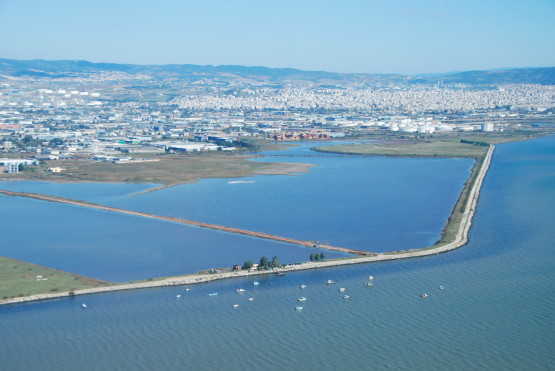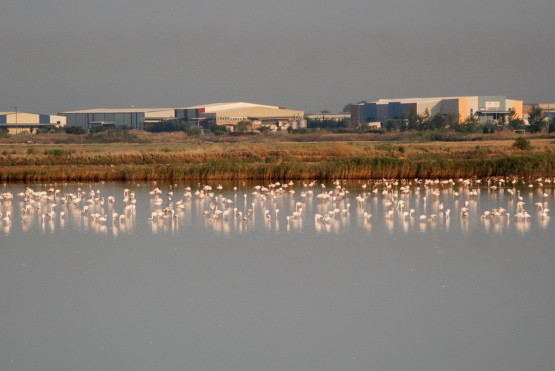National Park
Kalochori Lagoon
The lagoon of Kalochori constitutes the northern gate of the National Park, lying at a mere 8 km. from the city of Thessaloniki. This coastal wetland is of special interest since despite being at the edge of a large urban center with all the pressures that brings, it constitutes one of the most important areas of the National Park, hosting great numbers of birds and other organisms throughout the year. The lagoon often becomes a place of refuge for large numbers of flamingos, who find ample supplies of food in its shallow waters. The lagoon offers impressive images, with birds feeding off its water, with the urban landscape and the port cranes of Thessaloniki in the background.
The creation of the lagoon
The case of the lagoon of Kalochori is unique in Greece, as it constitutes a ‘young’ wetland, created gradually from the mid-60’s, as the result of the subsidence of the earth due to the excessive pumping of water from underground aquifers, combined with the loose composition of the soil.
Before river Axios was diverted in 1934, the region was covered in extensive marshes. During the years 1955 – 1980 the Water Supply Company of Thessaloniki performed numerous drillings in the region of the Gallikos river, in order to supply water to Thessaloniki, while many more drillings were performed by private companies. The result was that the underground aquifer of the region dropped by 36 meters since 1976. Also due to its loose composition, the clayey soil subsided at many points in the lagoon, even reaching a depth of 3-4 meters below sea level!
The contemporary lagoon was created in the ‘basin’ formed from the sea water which enters it underground, as well as by rainwater from the village of Kalochori. The creation of the lagoon was also reinforced by the construction of the coastal embankment in 1976, in order to protect the village of Kalochori from potential flooding.
Today, the lagoon of Kalochori covers an area of 226 hectares. The bed of the lagoon lies at 0.5 – 1 meter below sea level. Subsidence is also visible at the estuary of the Gallikos river, where one can see the telephone pillars inside the lagoon, where once a pasture existed.
SOURCES
Anastasiadis E.T., M. Seferlis, E.Fitoka, E. Mihalatu, D. Papadimos, S. Kastavouni, A. Apostolakis, M. Katsakiori, S. Kazantzidis, 2004. Restoration and conservation of the Kalohori lagoon, Thessaloniki. In: Arianoutsou & Papanastasis (eds), Proceedings 10th MEDECOS Conference, April 25 – May 1, 2004, Rhodes.
Κονταξή Χ., Βαρελτζίδου Σ., Πανταζόπουλος Χ., 2012. 5ο Πανελλήνιο Συνέδριο Περιβαλλοντικής Πολιτικής & Διαχείρισης, «Χωροταξικός Σχεδιασμός και Προστατευόμενες Περιοχές, το παράδειγμα της Λιμνοθάλασσας Καλοχωρίου στο Ν. Θεσσαλονίκης», 25-27 Μαΐου, Μυτιλήνη.


